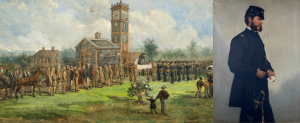By Heather Rockwood, Communications Manager
Happy Halloween season! The “dead” are everywhere you look, including in the MHS archives. From paintings to books, to letters and jewelry, the creators and wearers are all deceased. Although we know they are gone, we continue to research and talk about their lives. The following pieces from the MHS collection show us those that have died in a very real way.
These two paintings offer different perspectives on the dead—one of a deceased man who looks alive, and the other of corpse that is . . . stuffed. The first painting is of Captain George H. Bush of the 13th Regiment of Massachusetts Infantry. The painting jumped out at me because the artist made it postmortem, or after the subject has died. Most postmortem paintings show the subject sleeping or in repose, but Capt. Bush is standing, alive and well. The second painting is of the funeral of Billy Bruin, a bear that was supposed to be on display at an amusement park in Wellesley, Massachusetts, but soon after he arrived, he escaped and was found dead ten days later. His owner, who also owned the amusement park, decided to capitalize on Billy anyway and planned a lavish funeral for the bear. A stuffed Billy is atop a litter with people parading before and behind him in costume, military uniform, or festive dress, some play in a band. Other figures wear Native American clothing, but it is unclear if they are Indigenous people.

This beautiful brooch is a special piece in the MHS collection. The hair inside is from Mercy Otis Warren, who was an author and playwright who wrote a history of the American Revolution. After its publication in 1805, her friends, John and Abigail Adams read it, and because of its critical portrayal of John, the relationship broke off. However, in 1812 they rekindled the friendship and to celebrate, Abigail Adams had a ring and a brooch made for herself. The brooch contains Mercy’s hair intertwined with Abigail’s. Although the brooch was not made as a mourning object, Mercy passed in 1814 and Abigail most likely cared for this brooch as a memorial item of her friend. This can be speculated because hair jewelry was customarily made as remembrances or as memorials of a loved one.

Here is your warning that the following quote depicts a horrifying scene in the aftermath of the Battle of Shiloh, during the Civil War. Horace Newton Fisher wrote a letter to his father, Francis Fisher, on 10 April 1862, after participating in the battle, including this description:
It is estimated that the U.S. lost 7000 men and killed & wounded and 3000 prisoners…and that theirs exceeds 30000 men (by their own estimate). Most horrible thought! The dead men & dead horses lay in piles, the wounded were on every side.
His visual and evocative wording takes us to that battlefield and the colossal death, destruction, and tragedy that he witnessed before his eyes.

